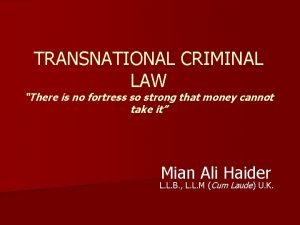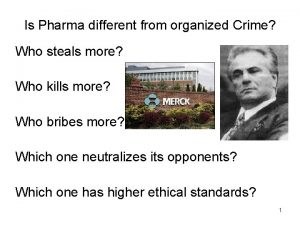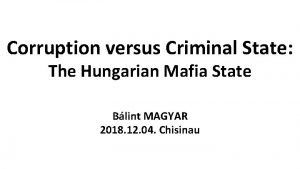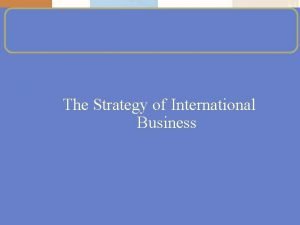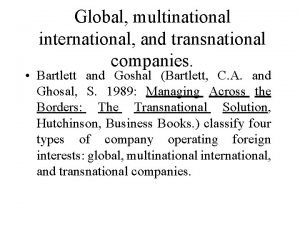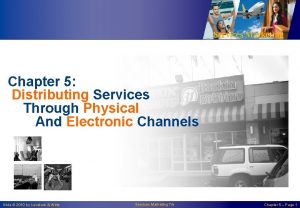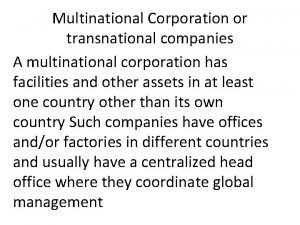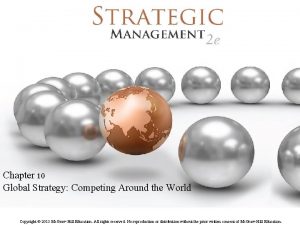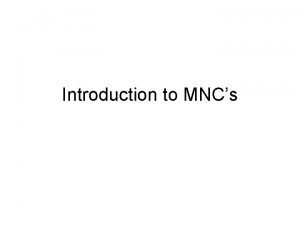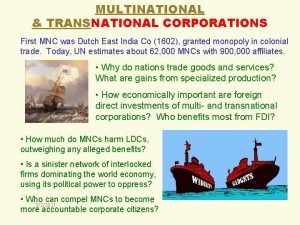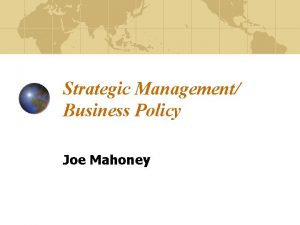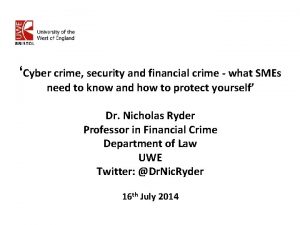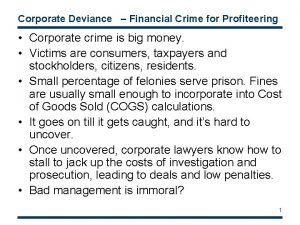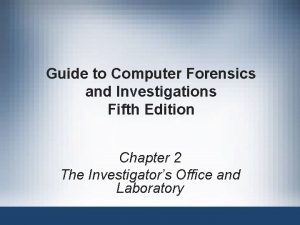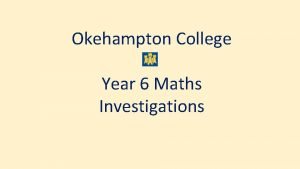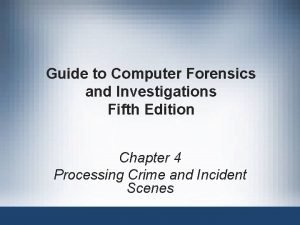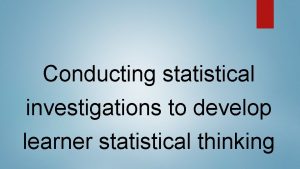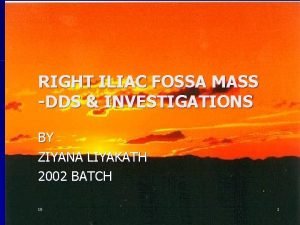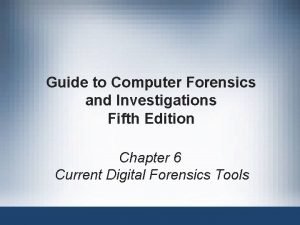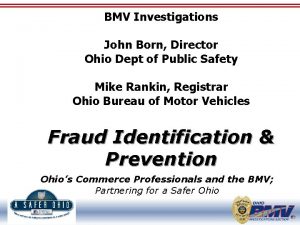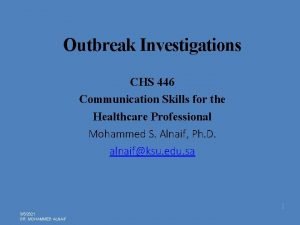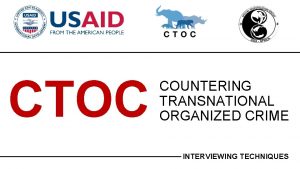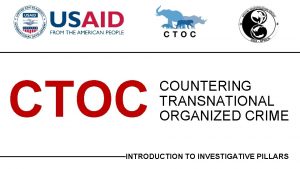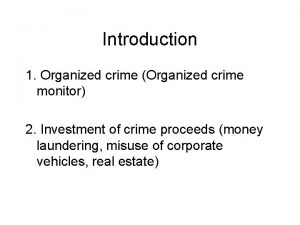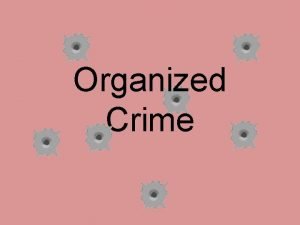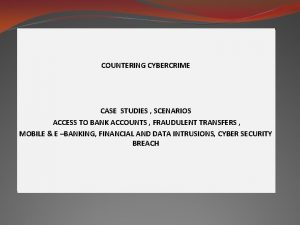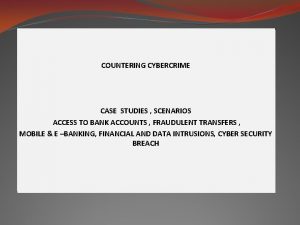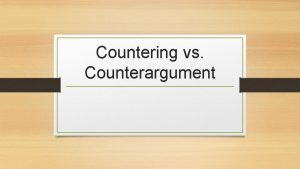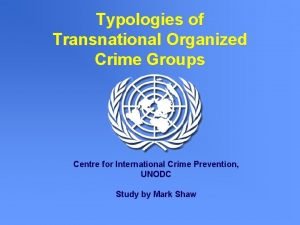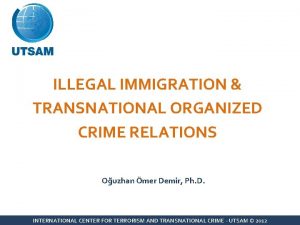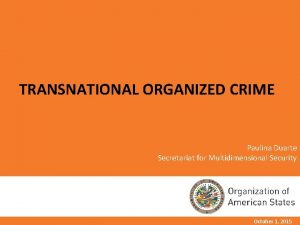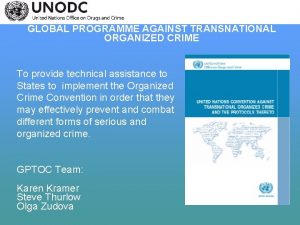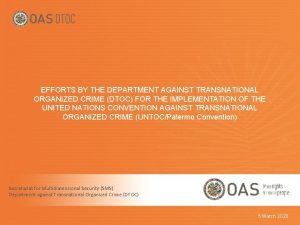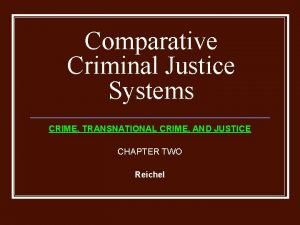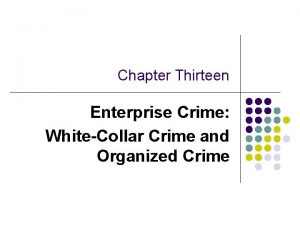CTOC COUNTERING TRANSNATIONAL ORGANIZED CRIME FINANCIAL INVESTIGATIONS COMPETENCIES








































- Slides: 40

CTOC COUNTERING TRANSNATIONAL ORGANIZED CRIME FINANCIAL INVESTIGATIONS

COMPETENCIES ACHIEVED Following this module, participants will be able to: ü Define a financial investigation and identify how it supports criminal investigations ü Identify sources of information for obtaining financial information ü Identify direct and indirect techniques commonly used for proving illegal income ü Identify three common indirect techniques of proving income ü Identify common defenses raised to indirect methods and steps to overcome them FINANCIAL INVESTIGATIONS

WHAT IS A FINANCIAL INVESTIGATION? • An investigative tool using financial information (and evidence) to support a substantive criminal offense (charge) e. g. proving the proceeds for money laundering • Corroborates the substantive criminal charge • Supports prosecution of “top management” in a criminal conspiracy • Supports seizures and forfeitures FINANCIAL INVESTIGATIONS

FINANCIAL INVESTIGATIONS Financial investigations to be initiated: 1. 2. 3. 4. 5. 6. 7. 8. Wildlife trafficking Drug trafficking Human trafficking Terrorism Money laundering Intellectual property theft Civil recovery Confiscation of assets FINANCIAL INVESTIGATIONS

ORGANIZED CRIME NUMBERS • • Drugs Counterfeiting Humans Oil Wildlife Timber Fish $320 billion $250 billion $31. 6 billion $10. 8 billion $7. 8 to $23 billion $7 billion $4. 2 to $9. 5 billion • All linked • All a threat to national security and stability FINANCIAL INVESTIGATIONS

WHY CONDUCT A FINANCIAL INVESTIGATION? • Detect: Identify trafficking organizations operating in your jurisdiction and their methods of operation • Disrupt: Disrupt their activities, and seize profits • Dismantle: Arrest, seize, and prosecute The best way to eliminate a criminal organization is to remove their profits, seize their assets (property, cash, etc. ) and arrest FINANCIAL INVESTIGATIONS

FINANCIAL PROFILING FINANCIAL INVESTIGATIONS

INITIATION Immediately initiate a financial investigation: It takes time Goals • Proving the crime • Tracing the assets • Freezing the assets • Confiscating the assets FINANCIAL INVESTIGATIONS

INITIATION Books and records • Profits/ losses • Track funds Source documents • Invoices: Bills • Receipts: Income • Checks FINANCIAL INVESTIGATIONS

FINANCIAL PROFILING • Lots can be learned about a subject by financially profiling them • Loans, bank records, wire transfers • Assets such as property, cars, companies, jewelry etc. • This can tell you who they are, who they deal with, transactions they have made on specific dates and times • As questions such as who, what, when, where, how, and why? FINANCIAL INVESTIGATIONS

FINANCIAL PROFILING • Total expenditure minus total source of legal income = funds from unknown sources • Identify the unknown sources of funds • Deposits: checks or cash/ wires (foreign) • Garbage pickup/ surveillance • Toll records (international calls? ) • Credit cards • Informants • Shell companies FINANCIAL INVESTIGATIONS

CTR AND SAR • Currency Transaction Report (anything above $10, 000) • Suspicious Activity Report (a notification from a bank) • Generated by financial institutions • The information is sent to Financial Investigative Units (FIU) • Can generate very good investigative leads FINANCIAL INVESTIGATIONS

FINANCIAL RECORDS • Get all the financial records • Analysis charts showing the flow of the money • Conduct a deposit and disbursement analysis • Conduct a net worth analysis (more difficult as it involves tax returns, gifts, inheritance, etc. ) FINANCIAL INVESTIGATIONS

TRACING FUNDS Two techniques for proving illegal income 1. Direct Method 2. Indirect Method FINANCIAL INVESTIGATIONS

TRACING FUNDS: DIRECT METHOD • Documentation received directly from: Subject of the investigation, during a search warrant, From an associate, informant or cooperating defendant • Full documentation of the specific source and disposition of funds is available: The source (subject, evidence seized from subject, an associate) provides a credible witness (direct evidence) that details, specific and documentable sources, amounts and dispositions of funds • The subject of the investigation is typically well-aware of the investigation or there is a high probability of the subject learning of the investigation FINANCIAL INVESTIGATIONS

EXAMPLE OF RECORDS SEIZED DURING A CRIMINAL INVESTIGATION FINANCIAL INVESTIGATIONS

TRACING FUNDS: INDIRECT METHOD • Indirect methods are techniques used to prove income from unknown sources through circumstantial (indirect) evidence Therefore: “Indirect” = Circumstantial Proof There are three Indirect Methods of tracing illicit income • One dependent upon the availability of detailed bank records • Two based on variations of a modified net worth schedule FINANCIAL INVESTIGATIONS

TRACING FUNDS: INDIRECT METHOD • Prove income based on the concept that all income, legal and illegal, can be applied to one of three dispositions: • Acquiring an asset • Reducing a liability • Expending on consumption • You must establish a firm starting point from which to document the disposition of funds FINANCIAL INVESTIGATIONS

TRACING FUNDS: INDIRECT METHOD • Used when financial records of a direct nature are not available to the investigator • Documentation obtained from sources such as tax returns, financial institutions, loan applications, credit card bills, and mortgage company records • Income is proven by documenting the disposition of funds (income = disposition) If a transaction is to be considered a money laundering violation, you must be able to prove involvement of Proceeds of SUA FINANCIAL INVESTIGATIONS

TRACING FUNDS: INDIRECT TECHNIQUES Bank deposits method: Most income has been deposited Source and applications of funds method: Income spent on lavish lifestyle with little net worth Net worth and expenditures method: Changes in financial status with few identifiable direct records. Best supports civil forfeiture of assets FINANCIAL INVESTIGATIONS

TRACING FUNDS: INDIRECT TECHNIQUES Bank Deposit Method: Used when the majority of a suspect’s funds have been deposited into a financial institution • Money received can be dealt with in two ways: deposited or spent in the form of cash • Spending cash can include converting it into a nondepository monetary instrument FINANCIAL INVESTIGATIONS

BANK DEPOSIT METHOD: FORMULA Total Deposits All Accounts Less (-) Transfers (one account to another) and re-deposits Equals (=) Net deposits to all accounts Add (+) Cash expenditures Equals (=) Total receipts from all sources Less (-) Funds from known or legal sources Equals (=) Income from unknown or illegal sources FINANCIAL INVESTIGATIONS

NET WORTH Assets – Liabilities = Net Worth • Net worth is a snapshot of a subject’s financial condition at a given point in time Used when: A subject’s income is spent on lavish living and there is little, if any, net worth FINANCIAL INVESTIGATIONS

NET WORTH & EXPENDITURES FORMULA Annual Assets Less (-) Liabilities Equals (=) Net worth Less (-) Prior year’s net worth Add (+) Expenditures on consumables Equals (=) Total income Less (-) Known source or income from legal sources Equals (=) Income from unknown or illegal sources FINANCIAL INVESTIGATIONS

COMMON DEFENSES RAISED AGAINST INDIRECT METHODS • Need to anticipate common defenses used by defendants when Indirect Methods are used to prove illegal income. • Must seek evidence to rebut these defenses during the financial investigation • #1 Defense: Cash hoard accumulation Establishing a firm financial starting point will defeat most defenses FINANCIAL INVESTIGATIONS

COMMON DEFENSES RAISED AGAINST INDIRECT METHODS To rebut most defenses, you must obtain evidence to refute claims of the sources of illegal income such as: • Loans • Gifts • Inheritances • Found money • Gambling winnings • Subject holding assets as a nominee • Commingled funds • Lottery winnings FINANCIAL INVESTIGATIONS

FINANCIAL TRANSACTIONS • • Money transfer (Western Union/ Money Gram) Telephone transfer Banking system Hawala Money couriers Stash houses Credit cards FINANCIAL INVESTIGATIONS

COURIERS FINANCIAL INVESTIGATIONS

$33, 761 FINANCIAL INVESTIGATIONS

$572, 744 FINANCIAL INVESTIGATIONS

$240, 685 FINANCIAL INVESTIGATIONS

INTERNATIONAL TRAVEL – PREPAID CARD • • • High anonymity/ high liquidity No exchange to local currency No identification ATMs open 24/7, use at retailers Immediate access to local currency FINANCIAL INVESTIGATIONS

CASH VS. CARD FINANCIAL INVESTIGATIONS

IMPORTANCE OF ASSET RECOVERY • Recovery of assets from criminals is damaging as it prevents them from enjoying the money after their sentence • Prevents the money being used to fund other illegal activities • Puts the organized crime syndicates out of business • Acts as a deterrent FINANCIAL INVESTIGATIONS

RED FLAG INDICATORS • Activity inconsistent with customer’s business • Persons involved in currency transactions share an address or phone number, particularly when the address is also a business location or does not seem to correspond to the stated occupation (e. g. student, unemployed, or self-employed) • Regarding nonprofit or charitable organizations, financial transactions occur for which there appears to be no logical economic purpose or no link between the stated activity and the other parties in the transaction FINANCIAL INVESTIGATIONS

RED FLAG INDICATORS • Safety deposit box opened on behalf of a commercial entity when the business activity is unknown or does not appear to justify the use of a safety deposit box • Large number of incoming or outgoing transfers take place through a business account without any logical economic purpose, particularly when activity involves high risk locations • Funds transfers are ordered in small amounts in an apparent effort to avoid triggering identification or reporting requirements FINANCIAL INVESTIGATIONS

RED FLAG INDICATORS • Funds transfers do not include information on the originator, or the person on whose behalf the transaction is conducted, when the inclusion of such information would be expected • Multiple personal and business accounts or accounts of nonprofit organizations or charities are used to collect and funnel funds to small number of foreign beneficiaries • Transactions involving foreign currency exchanges are followed within a short time by funds transfers to higher-risk locations FINANCIAL INVESTIGATIONS

RED FLAG INDICATORS • Foreign exchange transactions performed on behalf of customer by third party, followed by funds transfers to locations having no apparent business connection with customer or to higher-risk countries • Multiple accounts used to collect and funnel funds to small number of foreign beneficiaries, both persons and businesses, particularly in higher-risk locations • Banks from higher-risk locations open accounts FINANCIAL INVESTIGATIONS

RED FLAG INDICATORS • Customer obtains a credit instrument or engages in commercial financial transactions involving movement of funds to/ from higherrisk locations when there appear to be no logical business reasons for dealing with those locations • Funds sent or received via international transfers from/ to higherrisk locations • Insurance policy loans or policy surrender values that are subject to a substantial surrender charge FINANCIAL INVESTIGATIONS

QUESTIONS? COMMENTS? CONCERNS? Photo: R 4 robin via Wikimedia Commons/ CC BY-SA 4. 0 FINANCIAL INVESTIGATIONS
 Transnational crime and the developing world
Transnational crime and the developing world Transnational crime definition
Transnational crime definition Oklahoma city gangs
Oklahoma city gangs Organized crime osrs
Organized crime osrs Hungarian organized crime
Hungarian organized crime War making and state making as organized crime summary
War making and state making as organized crime summary Disney marketing mix
Disney marketing mix Multi domestic strategy
Multi domestic strategy A firm pursuing a transnational strategy would believe that
A firm pursuing a transnational strategy would believe that Multinational vs international
Multinational vs international Objectives of international hrm
Objectives of international hrm Marketing chapter 5
Marketing chapter 5 Transnational vs multinational
Transnational vs multinational Site:slidetodoc.com
Site:slidetodoc.com Nestle company organizational structure
Nestle company organizational structure Mnc introduction
Mnc introduction First mnc in world
First mnc in world A transnational corporate-level strategy seeks to achieve
A transnational corporate-level strategy seeks to achieve Multidomestic international strategy
Multidomestic international strategy Financial crime cyber security
Financial crime cyber security Financial crime
Financial crime Antenatal investigations
Antenatal investigations Unit 3 statistical studies answers
Unit 3 statistical studies answers Scientific method observation
Scientific method observation Digital forensic lab floor plan
Digital forensic lab floor plan Nrich maths investigations
Nrich maths investigations Investigations
Investigations Statistical investigations examples
Statistical investigations examples Right iliac fossa mass investigations
Right iliac fossa mass investigations Craigslist wayne
Craigslist wayne Guide to computer forensics and investigations
Guide to computer forensics and investigations Pasco county child protective services
Pasco county child protective services Chapter 6 fingerprints
Chapter 6 fingerprints Jarrod bowditch
Jarrod bowditch Marking bad clusters data hiding technique
Marking bad clusters data hiding technique Chs investigations
Chs investigations Toledo bmv heatherdowns
Toledo bmv heatherdowns Chs investigations
Chs investigations Why aren t descriptive investigations repeatable
Why aren t descriptive investigations repeatable Financial method of motivation
Financial method of motivation Core competencies analysis
Core competencies analysis

